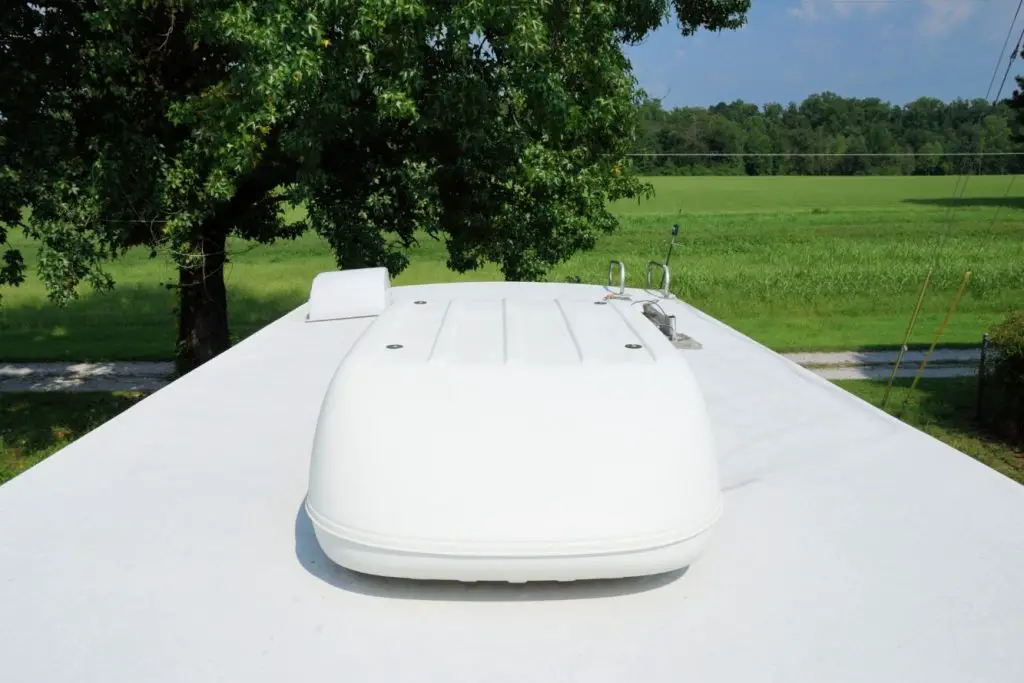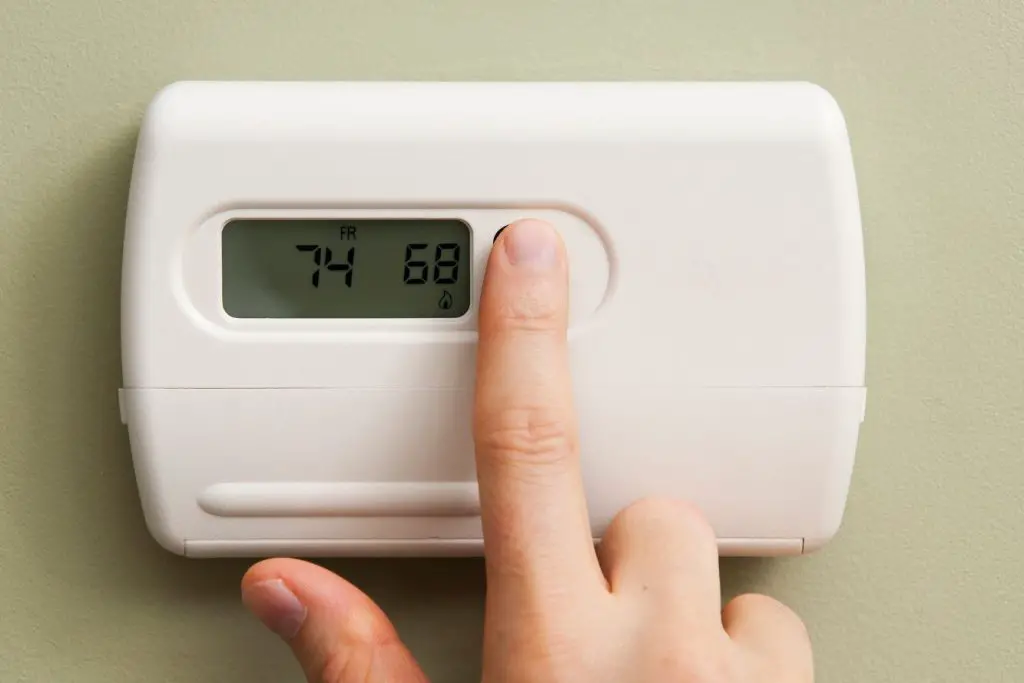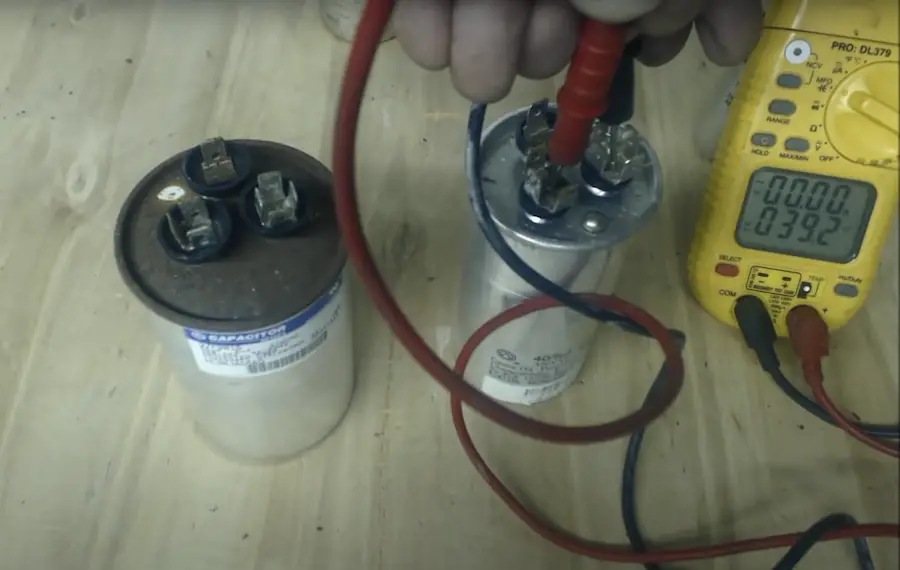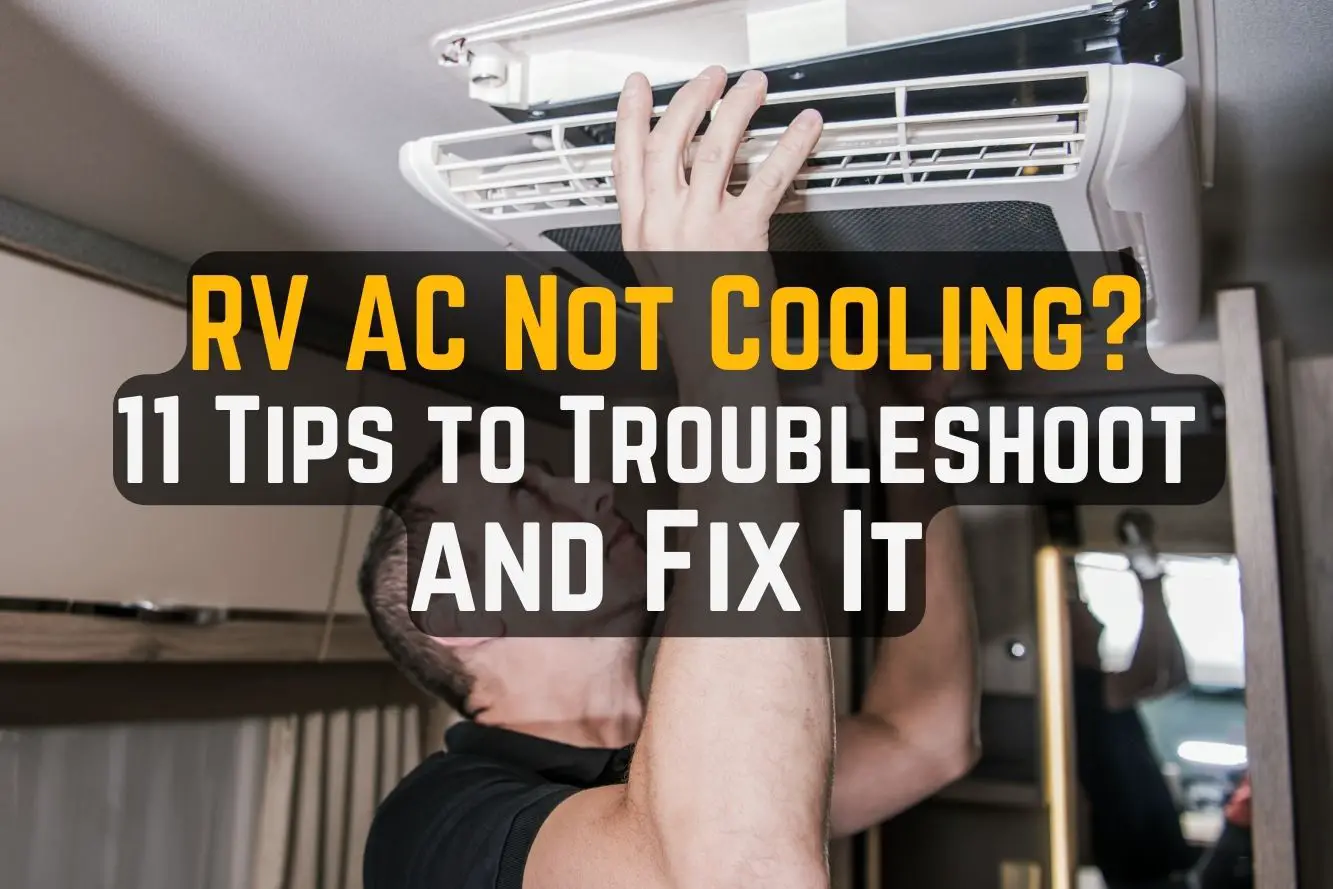Is your RV AC not cooling? If your air conditioner isn’t blowing cold air, don’t panic. The problem could end up being simple and easy to fix!
However, in some cases, the problem isn’t so easy.
In this article, we are covering 6 of the most common reasons for an RV air conditioner blowing warm air. We walk you through troubleshooting the problems from easiest to hardest – because it’s always smart to start with the easiest thing first.
Then, we give you 5 tips to help your RV air conditioner run more efficiently and blow colder air.
Let’s get started.
This article may contain affiliate links. This means that if you click a link on this page and purchase a product, we may earn a commission at no extra cost to you. Thanks for supporting RVHQ!
Table of Contents
Why Is My RV AC Not Cooling? 6 Possible Reasons For RV AC Blowing Lukewarm Air
If your RV air conditioner isn’t blowing cold air, you’re likely feeling hot and frustrated. If the AC is powered on and running but blowing lukewarm air, here are 5 common problems you may be facing.
- Dirty RV AC Unit – coils, fins, or compressor.
- Problems with the thermostat.
- Low freon levels.
- Problems with the fan or blower.
- An issue with the RV AC compressor.
- Problems with the AC capacitor.
It’s a good idea to start with the easiest potential problems first. In many cases, a dirty RV AC unit is the culprit – and it’s easy to clean and fix!
Let’s learn more about the RV air conditioner and dive deeper into troubleshooting each individual problem.
How RV Air Conditioners Work
Most RV air conditioners are the same. These roof-mounted appliances work by circulating Freon, a cooling fluid, through the fins and coils in the unit.
As it does this, a fan blows warm air past the coils and fins, cooling the air. The air is then circulated and blows back into your RV through your air conditioner vents.
The entire system is controlled by a switch in the thermostat in your RV – almost everyone is familiar with a thermostat!
The thermostat has a thermometer inside it, and when the RV temperature reaches the desired temp, it automatically shuts the AC off.
Since there are so many different components that make the RV air conditioning system work, the problem could be anywhere.
What To Do If Your RV Air Conditioner Isn’t Blowing Cold Air – Check the Power

First, if your RV air conditioner isn’t blowing cold air, it’s best to start with the easiest troubleshooting items.
If the unit is on and running but it’s only blowing lukewarm air, the first thing you should do is make sure you have enough power.
In the event that you don’t have enough power for the compressor to kick on, it will only run the fan, and the fan just blows warm or lukewarm air.
If you’re at a campground and are plugged into shore power, you should have enough power to run the AC. Make sure that you don’t have any other high-power-draw appliances running like a blow dryer or the microwave. Sometimes these appliances can draw too much power for your AC compressor to kick on.
If you know that you have enough power to run the AC, the first thing to check it the thermostat.
RV Thermostat Troubleshooting

If your thermostat is set at a lower temperature but your RV still isn’t blowing cold air, you may have a problem with the temperature sensor or the thermostat itself.
One way to tell if your thermostat is bad is by looking at the display – if the on/off switch is powering the fan but the display isn’t on, this is an indicator you need to replace your thermostat.
Sometimes, though, the problem is as simple as a loose wire or dead batteries. Some RV thermostats are hard-wired in. If this is the case for you, open the thermostat and make sure all the wires are properly connected.
And if it runs on batteries, you may just need to replace them!
If you need to replace your thermostat altogether, this is a pretty easy fix and you should be able to do it yourself. There are plenty of forums and vidoes on YouTube that can help you DIY it.
Clean & Inspect The Coils, Fins, and Condenser on Your AC Unit
If your thermostat isn’t the problem, the next easiest item to troubleshoot is to take a look at the air conditioner unit itself.
Most RVs have roof-mounted air conditioning units, so you’ll need to get on top of your RV.
Sometimes a dirty AC unit is the culprit behind an RV AC not cooling. And this is one of the easiest fixes there is!
Dirty coils, fins, or a dirty condenser unit can cause your air conditioner to blow lukewarm air. It can also cause it to freeze up entirely, which will prevent your air conditioner from cooling.
Your rooftop air conditioner unit is covered by a shroud that you need to remove to access the coils and fins to clean them.
This is a maintenance task that you should do once or twice a year to keep everything running smoothly.
All kinds of dirt and debris can get inside and hinder the operation of your AC.
Editor’s Note: We had the unfortunate experience of having to clean active wasps nests out of our RV AC unit when we first bought it. Anything can get in there and gunk it up!
How to Clean Your RV AC Unit
Supplies Needed:
- Screwdriver or drill to remove the shroud
- AC Coil cleaning spray
- A soft bristled brush
- AC fin comb
- A hose or water bucket
- Towels or paper towels
There are two sets of coils: an exterior set of condenser coils and a set of evaporator coils inside the AC. Both sets should be inspected and cleaned if they’re dirty!
- Turn off all power to your RV AC unit. Find the breaker that powers the AC and turn it off. Or, you can remove your RV from shore power and turn the battery disconnect switch to remove all 120v and 12v power to the AC.
- Remove the exterior AC shroud with your screwdriver or drill. Put the screws somewhere safe – a ziploc baggie or a zippered pocket are the best place!
- Remove the interior AC shroud with the screwdriver and put those screws in a separate safe place.
- Cover any electrical connections with plastic and be sure to cover the vent that goes into your RV to avoid pushing any dirt or water inside.
- Gently brush away any loose dirt and leaf debris before getting started.
- Then, using your AC coil cleaner or just soap and water, clean the coils and fins of your RV AC. Follow the directions on the coil cleaner if using it for best results.
- Be extra gently on the fins. They should all be straight. If they’re bent or crooked, use your AC fin comb to straighten them.
- Re-attach the interior and exterior shrouds and try your AC again.
Here’s a great video from RV Tips & Travels about how to clean your AC coils and fins.
Low Freon Levels
If your air conditioner isn’t blowing cold and you get up on the roof and notice ice or frost buildup on your RV AC, it may be frozen up or you may need to have it recharged with Freon.
Depending on your air conditioner model, it may be easy or difficult to recharge it with Freon.
You can purchase Freon refrigerant at some automotive stores or you can purchase it online. If you choose to do this yourself, be sure to research your RV air conditioner model to be sure you know what you’re doing.
Although this isn’t a particularly difficult task, it can be dangerous if you don’t know how to do it properly. If you do choose to add refrigerant yourself, you can find plenty of tutorials online.
If you feel unsure, you can always consult a professional to do it for you.
RV Air Conditioner Fan Troubleshooting
If the problem with your air conditioner is related to the fan, you may notice things like:
- The fan not coming on.
- It only works on the low setting.
- The fan is making strange noises or has a strange smell.
- The RV lights dim when the fan comes on.
Any of these symptoms may be a sign that your air conditioner fan is going out. It could be a problem with the fan motor, the capacitor, or the bearings. If you notice a bad or burning smell, turn it off immediately – this could be a fire hazard.
AC Compressor Troubleshooting
The compressor is basically the engine of the air conditioner. This part of the AC can freeze up and cause the air conditioner to blow out warm or lukewarm air. It can also go bad entirely.
Compressor issues can range from low Freon levels to dirty coils and fins. Sometimes, the compressor itself can go bad. If this is the case, you may need to replace the air conditioner altogether – but we definitely recommend consulting a professional first!
Air Conditioner Capacitor Troubleshooting

The capacitor is another essential piece of the RV air conditioner system. There are two capacitors in the AC: a motor run capacitor and a motor start capacitor. Problems with either of these will spell trouble for your air conditioner function.
These devices provide a boost of electricity to help kick your AC on and run the compressor. And sometimes they can go bad.
To diagnose whether or not you have a problem with your capacitor, there are certain signs and symptoms to keep an eye or ear out for.
- The air conditioner constantly trips a breaker or blows a fuse after only running for a few minutes.
- The fan only blows hot, warm, or lukewarm air – because the compressor isn’t kicking on.
- The AC unit hums when it tries to start.
Depending on how handy you are and how comfortable you are with DIY projects, you can try to test and replace your capacitors yourself.
You can test the capacitors with a multimeter. If you end up deciding to replace your capacitor, you should replace both of them. If one is going bad, it’s likely that the other one is also or may fail soon.
When to Consult a Professional RV AC Repair Service
When dealing with problems with your RV air conditioner unit, you should consult a professional any time you feel the problem is beyond your skill level or comfort level.
Things like replacing a thermostat and cleaning your RV AC unit are pretty easy to do yourself. But other things like working with wires, replacing capacitors and fans, or replacing the unit altogether are definitely more tricky.
Consult a professional RV air conditioner repair service if:
- You have tried troubleshooting and diagnosing but can’t fix the problem.
- You suspect the air conditioner needs repairs.
- You smell burning when you try to run the air conditioner.
- You feel uncomfortable diagnosing or doing DIY repairs.
Tips to Help Your RV Air Conditioner Run More Efficiently
Sometimes your RV air conditioner doesn’t cool your RV because it’s just too hot outside.
Summer in certain regions seems to get hotter and hotter every year, and the air conditioner has to do a lot of work to cool your RV down.
Before dumping a bunch of time and money into trying to repair your air conditioner, try these tips to see if it helps. Sometimes all your AC needs is a little help from you!
Some things, like not cooking or showering in your RV as much when it’s really hot, seem pretty obvious. Here are the top tips to help keep your RV cool in the heat.
Related: Do Pop Up Campers Have Air Conditioning? Does it Actually Work?
Park Your RV in the Shade
If you can park your RV in a shaded area or at least under one tree, this will help the air conditioner blow cold air and cool down the RV better. If your AC isn’t cooling and the RV is parked in full sun, this could be the culprit!
While the temperature might not feel much lower in the shade, the AC unit will greatly benefit from not being in direct sunlight.
Insulate Your Windows and Roof Vents
Some RVs are full of windows – and motorhomes have huge windshields and cab windows that allow tons of heat in.
To help your air conditioner run more efficiently, insulate your RV windows and roof vents.
You can use room-darkening curtains to prevent sunlight from getting into your RV, or you can use window covers or reflective insulation cut to fit the windows.
For motorhomes, you can purchase windshield covers to help keep the cab area cooler. Or, install curtains and block the cab area from the rest of the coach to help keep it cooler.
Clean and Replace Your RV AC Air Filters Regularly
Your RV air conditioner has a small foam filter on the inside of the RV. You should regularly check and clean the interior filter and replace it when necessary.
It’s easy to access this filter. Some slide right out, but on some models, you may need to remove a panel to access it.
Regularly Inspect, Clean, and Maintain Your RV Air Conditioner
In addition to regularly checking and cleaning the interior filter, you should also regularly inspect and clean your rooftop RV air conditioning unit.
As we discussed above, getting up on the roof and removing the AC shroud to clean the coils and fins will help keep your RV AC working effectively.
This maintenance should be done a couple of times per year. And watch out for wasps and bees’ nests!
Feeling Humid? Use a Dehumidifier
Some regions are extremely humid, and no matter how long your air conditioner runs, it still feels hot inside your RV.
This is likely due to the humidity. To help your RV air conditioner work more efficiently and help yourself feel cooler, consider using a dehumidifier inside your RV.
Dehumidifiers in RVs are useful in both the winter and summer months, especially if you’re in a humid location.
Wrapping Up
Nobody wants to have problems with their air conditioner. If your RV AC isn’t cooling, you probably want to find a solution… and fast!
If you can’t figure out the problem and have a big trip coming up, you can always buy a portable air conditioner until you have time to have the AC repaired.
But hopefully, after reading this article you have successfully diagnosed the problem… and we hope it’s an easy fix and your AC starts blowing cold air soon!


